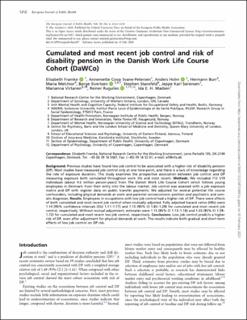| dc.contributor.author | Framke, Elisabeth | |
| dc.contributor.author | Svane-Petersen, Annemette Coop | |
| dc.contributor.author | Holm, Anders | |
| dc.contributor.author | Burr, Hermann | |
| dc.contributor.author | Melchior, Maria | |
| dc.contributor.author | Sivertsen, Børge | |
| dc.contributor.author | Stansfeld, Stephen A. | |
| dc.contributor.author | Sørensen, Jeppe Karl | |
| dc.contributor.author | Virtanen, Marianna | |
| dc.contributor.author | Rugulies, Reiner | |
| dc.contributor.author | Madsen, Ida E.H. | |
| dc.date.accessioned | 2021-02-22T08:19:16Z | |
| dc.date.available | 2021-02-22T08:19:16Z | |
| dc.date.created | 2021-01-10T18:32:21Z | |
| dc.date.issued | 2020 | |
| dc.identifier.citation | European Journal of Public Health. 2020, 30 (6), 1212-1218. | en_US |
| dc.identifier.issn | 1101-1262 | |
| dc.identifier.uri | https://hdl.handle.net/11250/2729357 | |
| dc.description.abstract | Background: Previous studies have found low job control to be associated with a higher risk of disability pension (DP). Most studies have measured job control only at one time-point, and there is a lack of knowledge regarding the role of exposure duration. This study examines the prospective association between job control and DP measuring exposure both cumulated throughout work life and most recent. Methods: We included 712 519 individuals (about 4.5 million person-years) from The Danish Work Life Course Cohort which follows young employees in Denmark from their entry into the labour market. Job control was assessed with a job exposure matrix and DP with register data on public transfer payments. We adjusted for several potential life course confounders, including physical demands at work and parental socioeconomic position and psychiatric and somatic diagnoses. Results: Employees in occupations with low job control had a higher risk of DP. There were effects of both cumulated and most recent job control when mutually adjusted. Fully adjusted hazard ratios (HRs) were 1.14 [95% confidence intervals (CIs) 1.11–1.17] and 1.15 (95% CI 1.02–1.29) for cumulated and most recent job control, respectively. Without mutual adjustment, estimates were 1.15 (95% CI 1.13–1.18) and 1.55 (95% CI 1.39– 1.72) for cumulated and most recent low job control, respectively. Conclusions: Low job control predicts a higher risk of DP, even after adjustment for physical demands at work. The results indicate both gradual and short-term effects of low job control on DP risk. | en_US |
| dc.language.iso | eng | en_US |
| dc.publisher | Oxford University Press | en_US |
| dc.rights | Navngivelse-Ikkekommersiell 4.0 Internasjonal | * |
| dc.rights.uri | http://creativecommons.org/licenses/by-nc/4.0/deed.no | * |
| dc.title | Cumulated and most recent job control and risk of disability pension in the Danish Work Life Course Cohort (DaWCo) | en_US |
| dc.type | Peer reviewed | en_US |
| dc.type | Journal article | en_US |
| dc.description.version | publishedVersion | en_US |
| dc.source.pagenumber | 1212-1218 | en_US |
| dc.source.volume | 30 | en_US |
| dc.source.journal | European Journal of Public Health | en_US |
| dc.source.issue | 6 | en_US |
| dc.identifier.doi | 10.1093/eurpub/ckaa107 | |
| dc.identifier.cristin | 1868396 | |
| dc.relation.project | Nordforsk: 75021 | en_US |
| dc.description.localcode | The Author(s) 2020. Published by Oxford University Press on behalf of the European Public Health Association. This is an Open Access article distributed under the terms of the Creative Commons Attribution Non-Commercial License (http://creativecommons. org/licenses/by-nc/4.0/), which permits non-commercial re-use, distribution, and reproduction in any medium, provided the original work is properly cited. For commercial re-use, please contact journals.permissions@oup.com doi:10.1093/eurpub/ckaa107 Advance Access published on 13 July 2020 | en_US |
| cristin.ispublished | true | |
| cristin.fulltext | original | |
| cristin.qualitycode | 1 | |

